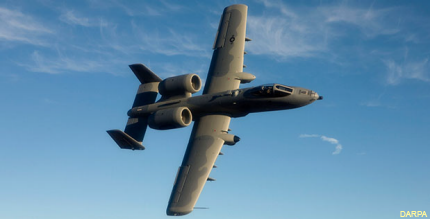Air support gets closer – and faster – with real-time data system
DARPA and the Air Force demonstrate PCAS, which cuts the arrival of munitions support to a matter of minutes.

The A-10 Thunderbolt II is the first Air Force craft to use PCAS.
Ground forces in need of munitions support soon may not have to wait very long for that support to arrive, now that military researchers and the Air Force have completed tests of a system that provides real-time information sharing, quick response and precise targeting.
The Defense Advanced Research Projects Agency earlier this year conducted the tests of the prototype Persistent Close Air Support (PCAS) system on an A-10 Thunderbolt II attack aircraft, completing 50 successful sorties near Nellis Air Force Base, Nev., from April to June, DARPA said. Those tests, the first involving PCAS on an Air Force aircraft, followed tests with the Marines using an MV-22 Osprey. As DARPA concludes the program, it plans to conduct transition activities with the Army with regard to both manned and unmanned aircraft.
To date, close air support, in which aircraft deliver munitions in support of ground forces, has relied on paper maps and voice communications, a system that can take a half-hour or more for the munitions to arrive. In all 50 of the PCAS tests with the A-10—10 of which involved live laser- or GPS-guided weapons—the munitions arrived within the target time of six minutes, DARPA said.
The prototype uses digital data links and advanced software running on a tablet computer to tie together ground controllers, aircraft and munitions. On the ground, a joint terminal attack controller (JTAC), using PCAS-Ground software, shares data with the pilot, who is using PACS-Air, an onboard automated targeting system.
In addition to speeding up the response times, the system also allows for more precise targeting, with the ability to use smaller munitions aimed at smaller, moving or multiple targets, which, DARPA noted, can reduce the incidence of friendly fire and collateral damage.
For the A-10 tests, DARPA used the Android Tactical Assault Kit, a version of PCAS-Ground developed with the Air Force Research Laboratory in conjunction with the U.S. Special Operations Command. ATAK, which provides situational awareness and targeting information, has already been deployed to thousands of users within the joint services.
“Close air support and similar operations rely on teamwork, and we have shown that a flexible architecture and extensible technology toolsets are key to making groundbreaking improvements in air-ground coordination,” Dan Patt, DARPA program manager, said in a statement. “These and other test results suggest PCAS-like approaches have the potential to provide an unprecedented synchronized understanding of the active battlefield.”
DARPA started PCAS in 2011, giving Raytheon a $7 million contract for work on Phase 1. The technology was matured during a year-long Phase 2, after which Raytheon got an 18-month, $25.5 million contract for Phase 3, with initial flight tests for PCAS beginning in November 2014.
The Osprey tests with the Marines, conducted in March during the Corps’ Talon Reach training exercise, marked the first successful integration of the full PCAS prototype, linking ground controllers, aircraft and munitions.
NEXT STORY: New Reaper variant stays aloft longer




